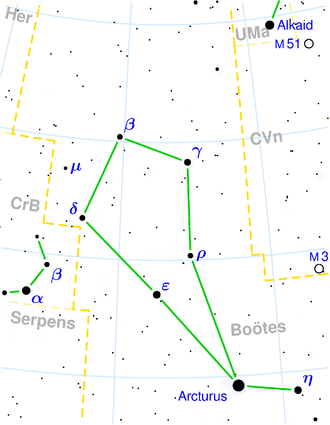NGC 5895
| Galaxie NGC 5895 | |
|---|---|
 | |
| NGC 5896 & NGC 5895 (u.) SDSS-Aufnahme | |
| AladinLite | |
| Sternbild | Bärenhüter |
| Position Äquinoktium: J2000.0, Epoche: J2000.0 | |
| Rektaszension | 15h 13m 50,0s[1] |
| Deklination | +42° 00′ 27″ [1] |
| Erscheinungsbild | |
| Morphologischer Typ | Sc [2] |
| Helligkeit (visuell) | 14,2 mag [2] |
| Helligkeit (B-Band) | 14,9 mag [2] |
| Winkelausdehnung | 0,9′ × 0,2′ [2] |
| Positionswinkel | 21° [2] |
| Flächenhelligkeit | 12,2 mag/arcmin² [2] |
| Physikalische Daten | |
| Rotverschiebung | 0,017856 ± 0,000140 [1] |
| Radialgeschwindigkeit | (5353 ± 42) km/s [1] |
| Hubbledistanz vrad / H0 | (245 ± 17) · 106 Lj (75,0 ± 5,3) Mpc [1] |
| Geschichte | |
| Entdeckung | R. J. Mitchell |
| Entdeckungsdatum | 23. Mai 1854 |
| Katalogbezeichnungen | |
| NGC 5895 • UGC 9774 NOTES01 • PGC 54366 • CGCG 221-042 NED01 • MCG +07-31-043 • IRAS F15120+4212 • GC 4072 • NSA 69289 • HOLM 701A | |
NGC 5895 ist eine 14,3 mag helle Spiralgalaxie vom Hubble-Typ Sc im Sternbild Bärenhüter am Nordsternhimmel. Sie ist schätzungsweise 245 Millionen Lichtjahre von der Milchstraße entfernt und hat einen Durchmesser von etwa 65.000 Lj. Wahrscheinlich ist sie gravitativ an NGC 5893 gebunden. Beide bilden sie mit NGC 5896 das optische Galaxientrio HOLM 701.
Das Objekt wurde am 23. Mai 1854 von R. J. Mitchell, einem Assistenten von William Parsons, entdeckt.[3]
Weblinks
- NGC 5895. DSO Browser, abgerufen am 11. Mai 2016 (englisch).
- Auke Slotegraaf: NGC 5895. Deep Sky Observer's Companion, abgerufen am 11. Mai 2016 (englisch).
- NGC 5895. SIMBAD, abgerufen am 11. Mai 2016 (englisch).
Einzelnachweise
Auf dieser Seite verwendete Medien
Autor/Urheber: Sloan Digital Sky Survey, Lizenz: CC BY 4.0
The sky image is obtained by Sloan Digital Sky Survey, DR14 with SciServer.
Angle of view: 4' × 4' (0.3" per pixel), north is up.
Details on the image processing pipeline: https://www.sdss.org/dr14/imaging/jpg-images-on-skyserver/



